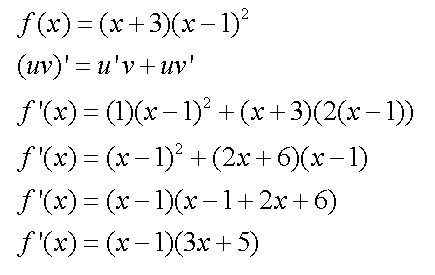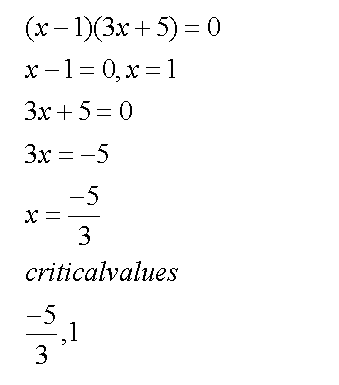Calculus: Early Transcendentals
8th Edition
ISBN:9781285741550
Author:James Stewart
Publisher:James Stewart
Chapter1: Functions And Models
Section: Chapter Questions
Problem 1RCC: (a) What is a function? What are its domain and range? (b) What is the graph of a function? (c) How...
Related questions
Question
![### Function Analysis: \( f(x) = (x + 3)(x - 1)^2 \)
#### (A) Finding Critical Values
You are asked to find all critical values of the function \( f \). If there are no critical values, enter -1000. If there are more than one, enter them separated by commas.
\[ \text{Critical value(s)} = \_\_\_\_\_\_\_\_\_ \]
#### (B) Indicating Increasing Intervals
Use interval notation to indicate where the function \( f(x) \) is increasing.
**Note:** When using interval notation in WeBWorK, use `I` for \( \infty \), `-I` for \( -\infty \), and `U` for the union symbol. If there are no values that satisfy the required condition, enter "{}" without quotation marks.
\[ \text{Increasing:} = \_\_\_\_\_\_\_\_\_ \]
#### (C) Indicating Decreasing Intervals
Use interval notation to indicate where the function \( f(x) \) is decreasing.
\[ \text{Decreasing:} = \_\_\_\_\_\_\_\_\_ \]
#### (D) Finding Local Maxima
Find the \( x \)-coordinates of all local maxima of the function \( f \). If there are no local maxima, enter -1000. If there are more than one, enter them separated by commas.
\[ \text{Local maxima at } x = \_\_\_\_\_\_\_\_\_ \]
#### (E) Finding Local Minima
Find the \( x \)-coordinates of all local minima of the function \( f \). If there are no local minima, enter -1000. If there are more than one, enter them separated by commas.
\[ \text{Local minima at } x = \_\_\_\_\_\_\_\_\_ \]
#### (F) Indicating Concave Up Intervals
Use interval notation to indicate where the function \( f(x) \) is concave up.
\[ \text{Concave up:} = \_\_\_\_\_\_\_\_\_ \]
#### (G) Indicating Concave Down Intervals
Use interval notation to indicate where the function \( f(x) \) is concave down.
\[ \text{Concave down:} = \_\_\_\_\_\_\](/v2/_next/image?url=https%3A%2F%2Fcontent.bartleby.com%2Fqna-images%2Fquestion%2F98a85d3f-1221-4cd9-b5c2-c225eed9a46f%2F260db02c-e093-4846-8a2e-3839612c55d0%2Fmec8q2.png&w=3840&q=75)
Transcribed Image Text:### Function Analysis: \( f(x) = (x + 3)(x - 1)^2 \)
#### (A) Finding Critical Values
You are asked to find all critical values of the function \( f \). If there are no critical values, enter -1000. If there are more than one, enter them separated by commas.
\[ \text{Critical value(s)} = \_\_\_\_\_\_\_\_\_ \]
#### (B) Indicating Increasing Intervals
Use interval notation to indicate where the function \( f(x) \) is increasing.
**Note:** When using interval notation in WeBWorK, use `I` for \( \infty \), `-I` for \( -\infty \), and `U` for the union symbol. If there are no values that satisfy the required condition, enter "{}" without quotation marks.
\[ \text{Increasing:} = \_\_\_\_\_\_\_\_\_ \]
#### (C) Indicating Decreasing Intervals
Use interval notation to indicate where the function \( f(x) \) is decreasing.
\[ \text{Decreasing:} = \_\_\_\_\_\_\_\_\_ \]
#### (D) Finding Local Maxima
Find the \( x \)-coordinates of all local maxima of the function \( f \). If there are no local maxima, enter -1000. If there are more than one, enter them separated by commas.
\[ \text{Local maxima at } x = \_\_\_\_\_\_\_\_\_ \]
#### (E) Finding Local Minima
Find the \( x \)-coordinates of all local minima of the function \( f \). If there are no local minima, enter -1000. If there are more than one, enter them separated by commas.
\[ \text{Local minima at } x = \_\_\_\_\_\_\_\_\_ \]
#### (F) Indicating Concave Up Intervals
Use interval notation to indicate where the function \( f(x) \) is concave up.
\[ \text{Concave up:} = \_\_\_\_\_\_\_\_\_ \]
#### (G) Indicating Concave Down Intervals
Use interval notation to indicate where the function \( f(x) \) is concave down.
\[ \text{Concave down:} = \_\_\_\_\_\_\
Expert Solution
Step 1
Given function

Find the critical values for the given function. To find critical values we need to take derivative
Step 2
Apply product rule to find derivative

Step 3
Set the derivative =0 and solve for x

Step by step
Solved in 6 steps with 6 images

Knowledge Booster
Learn more about
Need a deep-dive on the concept behind this application? Look no further. Learn more about this topic, calculus and related others by exploring similar questions and additional content below.Recommended textbooks for you

Calculus: Early Transcendentals
Calculus
ISBN:
9781285741550
Author:
James Stewart
Publisher:
Cengage Learning

Thomas' Calculus (14th Edition)
Calculus
ISBN:
9780134438986
Author:
Joel R. Hass, Christopher E. Heil, Maurice D. Weir
Publisher:
PEARSON

Calculus: Early Transcendentals (3rd Edition)
Calculus
ISBN:
9780134763644
Author:
William L. Briggs, Lyle Cochran, Bernard Gillett, Eric Schulz
Publisher:
PEARSON

Calculus: Early Transcendentals
Calculus
ISBN:
9781285741550
Author:
James Stewart
Publisher:
Cengage Learning

Thomas' Calculus (14th Edition)
Calculus
ISBN:
9780134438986
Author:
Joel R. Hass, Christopher E. Heil, Maurice D. Weir
Publisher:
PEARSON

Calculus: Early Transcendentals (3rd Edition)
Calculus
ISBN:
9780134763644
Author:
William L. Briggs, Lyle Cochran, Bernard Gillett, Eric Schulz
Publisher:
PEARSON

Calculus: Early Transcendentals
Calculus
ISBN:
9781319050740
Author:
Jon Rogawski, Colin Adams, Robert Franzosa
Publisher:
W. H. Freeman


Calculus: Early Transcendental Functions
Calculus
ISBN:
9781337552516
Author:
Ron Larson, Bruce H. Edwards
Publisher:
Cengage Learning